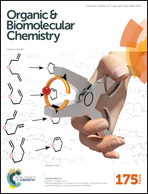The discovery of allyltyrosine based tripeptides as selective inhibitors of the HIV-1 integrase strand-transfer reaction†
Abstract
From library screening of synthetic antimicrobial peptides, an O-allyltyrosine-based tripeptide was identified to possess inhibitory activity against HIV-1 integrase (IN) exhibiting an IC50 value of 17.5 μM in a combination 3′-processing and strand transfer microtitre plate assay. The tripeptide was subjected to structure–activity relationship (SAR) studies with 28 peptides, incorporating an array of natural and non-natural amino acids. Resulting SAR analysis revealed the allyltyrosine residue was a key feature for IN inhibitory activity whilst incorporation of a lysine residue and extended hydrophilic chains bearing a terminal methyl ester was advantageous. Addition of hydrophobic aromatic moieties to the N-terminal of the scaffold afforded compounds with improved inhibitory activity. Consolidation of these functionalities lead to the development of the tripeptide 96 which specifically inhibited the IN strand-transfer reaction with an IC50 value of 2.5 μM.


 Please wait while we load your content...
Please wait while we load your content...